语言学教案Chapter 9 Language and Literature
- 格式:doc
- 大小:91.00 KB
- 文档页数:7

Chapter 9 Language and Culture 1.General Introduction1.1 The Relationship between Language and Culture●Relevant Language Use Observations and Questions to Ponder over1) In the following two conversations, the second speaker respondeddifferently towards the same question. And what do you think aChinese speaker will answer the same question?Conversation 1: between English speakersA: I like your sweater!B: Thank you!Conversation 2: between an English speaker and a Frenchspeaker.A: I like your sweater!B: Ah bon? Mais c’est très vieux ! (Oh, really? It’s very old!)2) Look at the following English words. Is there some connection between these words?bash, mash, smash, crash, dash, lash, clash, trash, splash, flash☺ /ʃ/: this sound suggests a sudden, violent movement/action foran English speaker3) The following lines are taken from a Singapore film I Not Stupid. Can you draw a conclusion from what you have read about Singlish?☺ Singlish/Singaporean: an English variety popular in SingaporeMom: Selina, where is all the ang pow that you got for yourbirthday?Selina(Daughter): That’s my money. Why I must give it to youevery time?Terry(Son): Yeah, lah. 为什么都要给你?Mom: 我知道这是你们的钱,but I will help you save, invest, hah. Don’t worry. I will give it back to you when you are old enough.Selina: When can you give it back to us?Terry: I know. 55岁。

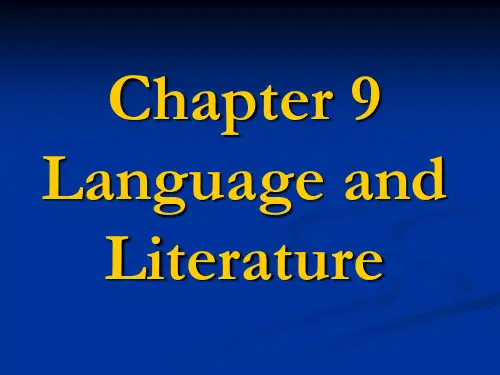
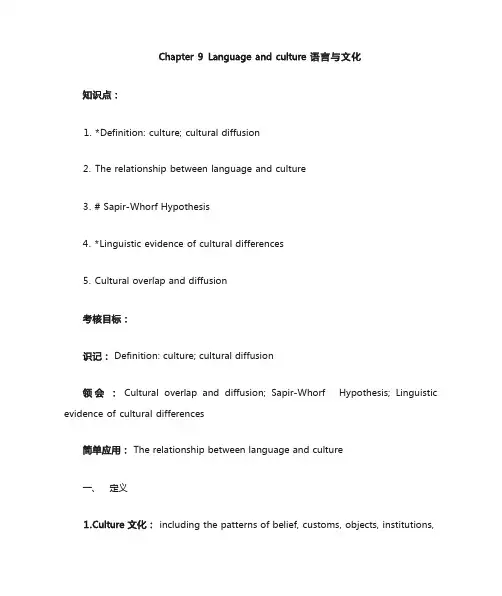
1. *Definition: culture; cultural diffusion2. The relationship between language and culture3. # Sapir-Whorf Hypothesis4. *Linguistic evidence of cultural differences5. Cultural overlap and diffusionDefinition: culture; cultural diffusionCultural overlap and diffusion; Sapir-Whorf Hypothesis; Linguisticevidence of cultural differencesThe relationship between language and culture一、定义including the patterns of belief, customs, objects, institutions,techniques, and language that characterizes the life of the human community. 由信仰,风俗,目标,机构,技术和语言构成,具有人类社区生活的特征。
through communication, some elements ofcultureA enter cultureB andbecomepartof cultureB. 通过交际, A 文化中的某些成分进入了 B 文化,并成为了 B 文化的一部分。
二、知识点techniques, and language that characterizes the life of the human community. 由信仰,风俗,目标,机构,技术和语言构成,具有人类社区生活的特征。
Twotypes of culture:1. material culture 物质文化: is concrete, substantial and observable. 具体的,实质的,可观察到的( e.g.意识文化、信念、价值观,时空概念)2. spiritual culture 精神文化: is abstract, implicit, and hidden. 抽象的,多义的,不可见的。
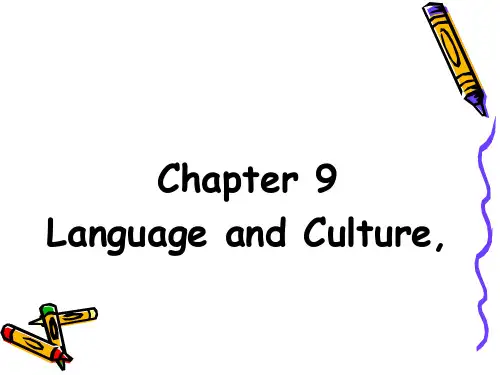

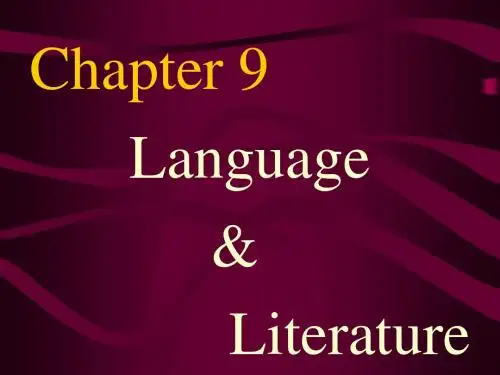

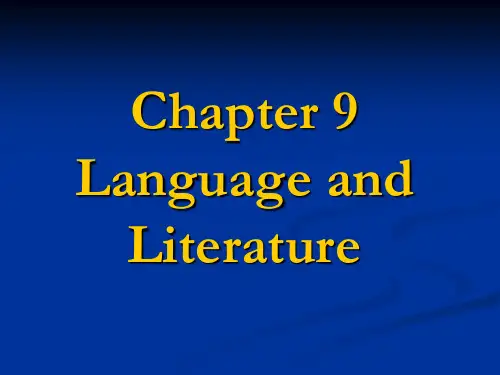
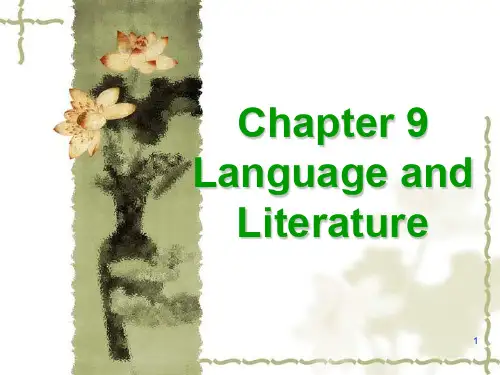

Chapter 9 Language and Literature9.1 Introduction9.1.1 Stylistics and Rhetoric9.1.2 Style9.2 Style investigation9.2.1 Deviance, Prominence and Foregrounding9.3 Levels of Style9.3.1 Phonological Level9.3.2 Lexical Level9.3.3 Syntactical Level9.1 Introduction9.1.1 Stylistics and RhetoricAs a branch of linguistics, stylistics is both old and young. It is quite “old”, because historically, we may find its origin in rhetoric, which dates back to the 5th century B.C.. Nowadays, some people still identify stylistics with rhetoric. But their difference is quite evident: Rhetoric is mainly concerned with the way to present ideas. It deals with how to say what you have to say. In its grand tradition marked by those distinguished names, such as Socrates, Plato, Aristotle etc., it has been the deliberate exploitation of eloquence for the most persuasive effect in public speaking or in writing. Modern critics sometimes refer to the rhetorical dimension of a literary work, meaning those aspects of the work that persuade or otherwise guide the responses of the readers.Stylistics, in modern sense, is closely related to modern linguistics, in which linguists find a systematic and scientific approach towards language. So stylistics can be simply defined as the linguistic studies of style. It develops with the development of modern linguistics.9.1.2 StyleGenerally speaking, the word style refers to the way in which language is used in a given context, by a given person, for a given purpose, and so on. In practice, writers on style differ a great deal in their understanding of the subject, and one reason comes from their disagreement over the question “To what or whom do we attribute style?”According to Roman Jakobson, there are sis constitutive factors in any speech event:ContextMessageAddresser AddresseeContactCodeThese factors are, according to our understanding, writer, text, reader, context and meaning. 9.2 Style investigation9.2.1 Deviance, Prominence and ForegroundingThree concepts and their interrelationship are crucial in our investigation of style.Deviance: A statistical notionIt is the difference between the normal frequency of a feature, and its frequency in the text or corpus.Deviance is achieved by a writer, which can be calculated and may escape reader’s attention.Prominence: A psychological notion“The general name for the phenomenon of linguistic highlighting, whereby some linguistic feature stands out in some way” (Halliday).We assume that p rominence of various degrees and kinds provides the basis for a reader’s subjective recognition of a style.Foregrounding:“value in the game” (Halliday)Artistically or functionally motivated deviationWhatever is prominent is considered foregrounding to achieve certain effect. Foregrounding may be:qualitativeThe deviation from the language code itself, i.e. failing to observe some rules or conventionsof the language, for example:There was things which he stretched, but mainly he told the truth. (Mark Twin)He gave it to me —for an unbirthday present. (Lewis Carroll)quantitativeThe deviation from some expected frequency, for example:(1)The way nothing is accompanied, he thought. His mouth was too dry to speak but he could not reach for the water. Now I must get him alongside this time, he thought. I am not good for many more turns. Yes, you are, he told himself. You are good forever. On the next turn he nearly had him. But again, the fish righted himself and swam slowly away.(2)He took all his pain and what left of his strength and his long-gone pride and he put it against the fish’s agony and the fish came over onto his side and swam gently on his side, his bill almost toughing the planking of the skiff, and started to pass the boat, long, deep, wide, silver and barred with purple and interminable in the water.Any text set an expected frequency. Paragraph (1), filled with short sentences, is a typical Heminwayan paragraph. All together it contains 8 short sentences. Paragraph (2) quoted from the same novel, The Old Man and Sea, has only one long sentence. So it is quantitatively deviated from the expected frequency of Heminwayan text.We may place the three notions of saliency in an ordered relation as follows:Foregrounding Psychological Statistical(functional relevance) (Prominence) (Deviance)We interpret the arrow in “X Y” to mean “all instances of X are instances of Y”. bUt in the opposite direction, the relation does not hold.9.3 Levels of StyleIn the linguistic method, we operate language as a communicative coding system that comprises different levels presented as follows:Written Language Lexical level Lexical levelSpeaker Reader encodes Syntactical level Syntactical level decodes Phonological level Phonological levelSince we look at this method may work in both literary and non-literary context. It is on these levels that we search for potential stylistic markers.9.3.1 Phonological LevelAs we are mainly concerned with written texts, much of the discussion about sounds, stress, pitch and intonation patterns has been left out. Nonetheless, some knowledge of phonology is quite necessary, since written language has the so-termed “phonic potentials”. Texts, for example,a poem, a dramatic dialogue, are often written with the spoken word in mind.1.Sound PatterningSound patterning refers to the matching of identical or similar sounds between two or more words. English words may consist of one or more syllables. Let us examine the possible types of sound patterning between monosyllabic words. The patterning can be represented as C V CThe love for rhythmic patterning of sounds, usually between content words, seems to be instinctive and examples abound in daily speech. For example:words and phrases: riff-raff, zig-zag, pell-mell, tit for tat, see-sawnick names: Nicky Mouse, Simple Simon, Tricky VickySound patterning is not only a source of aesthetic satisfaction, but also a phonological means of emphasis. For example:On the morning of February 12, a Sunday, the granny woman was there at the cabin. And she and Tom Lincoln and the moaning Nancy Hanks welcomed into the world of battle and blood, of whispering dreams and wistful dust, a new child, a boy. (Carl Standburg, Nancy Hanks)2.OnomatopoeiaSome words such as sizzle, bang, moo, hiss, are said to be onomatopoeic. These words are thought to be capable of producing sound images, and are imitative of their senses, for example, cackle, chuckle, giggle. But the relationship between the sound and the sense of a word is purely arbitrary. Some linguists have rightly pointed out that “onomatopoeia is actually the mutual reinforcement of sense by sound and sound by sense”. Let’s see the opening sentence of D.H. Lawrence’s Odour of Chrysanthemums:The small locomotive engine, Number 4, came clanking, stumbling down from Selston with seven full wagons.The sense of listening to and “feeling” the motion of the locomotive is created by a combination of rhythm (the trochaic regularity of “clanking, stumbling, down from Selston”), the dragging effect of consonants (/k/, /t/, /b/).3.ElisionElision refers to the omission of a sound or sounds in speech. For example:Next week /neks wi:k/ (/t/ elided)Wouldn’t he come /wudn i k m/ (/t/ and /h/ elided)Elided forms are perfectly acceptable and common in ordinary conversational speech esp. in rapid speech. Yet, when rendered in written form, they often become markers of a very informal, or casual style, with a hint of sloppiness and laziness in speech. For example,(Houlden makes a phone call. He is very drunk.)“Who is this?” this very cold, lady’s voice said.“This is me, Houlden Caulfield. Lemme speaka Sally, please.”“Sally’s asleep… Do you know what time it is?”“Yeah. Wanna talka Sally. Very important. Put her on.”(J.D. Salinger, The Catcher in the Rye) 9.3.2 Lexical LevelIn their long-term use, many words have acquired stylistic features, which make them appropriate for different contexts. These distinctive features constitute the stylistic colouring of the words.The stylistic differentiation on the lexical level is especially true of synonyms. It is observed that there are few words which have both the same referential meaning and stylistic meaning. Martin Joos in his The Five Clocks suggests five degrees of formality: “frozen”, “formal”, “consultative”, “casual”, and “intimate”. Accordingly, the synonyms charger, steed, horse, nag, plug can be labeled as such respectively.Look at the following two sentences:They chucked a stone at the cops, and then did a bunk with the loot.After casting a stone at the police, they absconded with the money.The lexical feature of the two sentences makes their stylistic meaning conspicuous: Sentence (1) may come from two criminals’ conversation, cas ually mentioning the crime afterwards, so many slang words are used. Sentence (2) may be from some official report, and thus the words used are literary (cast, abscond) or neutral (police, money).1.Special Word TypesSome words do not belong to the common core of the language and have distinctive2. Figures of SpeechAs to those common words, sometimes they are used literally, and sometimes figuratively. The figurative language is usually of high stylistic significance.Figurative Use Definition ExampleSimile A comparison between twodistinctly different things and thecomparison is indicated by the wordas or like.O my love’s like a red, red rose. They all rose as one man.Metaphor The use of a word which originallydenotes one thing to refer to anotherwith a similar quality.He is the soul of the team.Personification It is to treat a thing or an idea as if itwere human or had human qualities. Youth is hot and bold, Age is weak and cold.Metonymy It is substituting the name of onething for that of another with whichit is closely associated. When the war was over, he laid down the sword and took up the pen.Synecdoche A part is substituted for the whole The farms were short of handsor the whole is substituted for apart.during the harvest season.Euphemism The substitution of a mild or vagueexpression for a harsh or unpleasantone. to leave us (one’s heart has stopped beating)Overstatement The diction exaggerates the subject. She is dying to know what job hasbeen assigned for her.Understatement The words play down themagnitude or value of the subject. It took a few dollars to build this indoor swimming poolIrony The use of words which are clearlyopposite to what is meant, in orderto achieve a special effect. His designs were strictly honorable, as the saying is; that is; to rob a lady of her fortune by way of marriage.Transferred Epithet An epithet is an adjective ordescriptive phrase that serves tocharacterize somebody orsomething. A transferred epithet isone that is shifted from the noun itlogically modifies to a wordassociated with that noun. She was so worried about her son that she spent several sleepless nights.Oxymoron Contradictory terms combined toproduce a special effect. When the news of the failure came, all his friends said that it was a victorious defeat.9.3.3 Syntactical Level9.3.3.1 Sentence TypesAccording to different criteria, the English sentences can be classified into different types, and they each manifest distinctive stylistic features and are suitable for different ideas expressed.1.Classification according to COMPLEXITYSimple SentenceA simple sentence has only one predicate. Short simple sentences are usually emphatic. They have special clarity, and provide variety when used with longer sentences, for example,People think I am foolish and ignorant, but I’m not. I listen. I hear. I see. I think.I read. I walk alone by myself. (Taylor Caldwell, Testimony of Two Men)Compound SentenceA compound sentence consists of two or more independent clauses (or simple sentences) related to each other in meaning, and linked by a coordinating conjunction or by a semicolon without a conjunction.Compound sentences present coordinate ideas that are compatible and roughly equal in importance, and thus convey a sense of balance. Or it can be used to relate things in their natural order of happening. They are often employed in story-telling: the narration is fluent and friendly. It is easy and comfortable for the reader or listener to follow. For example:Once there was a shark and there was another shark and they ate fishes and they got so fat that they exploded.Complex SentenceA complex sentence contains at least one main clause and one or more subordinate clauses with a connective word denoting the relation between the two parts.Complex sentences express complex ideas clearly and accurately. They are capable of presenting complex psychological activities or complicated interrelations among different things. For instance:She could not think without anger, hardly without contempt, on the easiness of temper, that what want of proper resolution which now made him the slave of his designing friends, and let him to sacrifice his own happiness to the caprice of their inclinations.(Jane Austin, Pride and Prejudice)2. Classification according to INFORMATION ARRANGEMENTLoose Sentence and Periodic SentenceA loose sentence puts the main idea before all supplementary information; in other words, it puts first things first, and lets the reader know what it is mainly about when he has read the first few words. The reverse arrangement makes a periodic sentence: the main idea is expressed at or near the end of it, and it is not grammatically complete until the end is reached. The reader does not know what it is mainly about until he finishes reading it. Foe instance:a. She decided to study English though she was interested in music. (Loose Sentence)b. Although she was interested in music, she finally decided to study English. (Periodic Sentence) Loose sentences are easier, simpler, and more natural and direct. The tone is easy, relaxed and informal; periodic sentences are more complex, emphatic, formal, or literary.Inverted SentenceAn inverted sentence is a sentence with a change in normal word order.An inverted sentence is also emphatic, because the unusual word order draws readers’ attention: The poet was poor, and poor he remained all his life.On other occasions, inversion may help to enhance the cohesion in the context:They laughed together, and with that laugh ended all serious discourse.(R.Kipling, The Light that Failed)Elliptical SentenceIn an elliptical sentence, there is omission of one or more words that obviously understood but that must be supplied to make a construction grammatically correct.The focus of information in an elliptical sentence is foregrounding. This type of sentence is simple, direct and eye-catching. It is frequently used in spoken language nad advertising, and literary works as well:A beautiful way to Stop Fueling Around.No, not like that. A barren land, bare waste. Vulcanic lake, the dead sea; no fish, weedless, sunk deep in the earth.(James Joyce, Ulysses)9.3.3.2 Deviance on Syntactical LevelIn our reading, we may come across some grammatically incorrect sentences. Sometimes they are deviance by violating grammatical rules on purpose, say, to show the speaker is not well-educated, or is a child:Misuse of helping worde.g. He done gone. (He has gone.)2) Absence of the link-verbe.g. That (is) where he is.3) Non-standard auxiliarye.g. I ain’t (am not) talking with you.4) Disagreement in person or number.e.g. Has (have) I talked wild?The uses of rhetorical devices are modes of deviance on the syntactical level. For instance:1.RepetitionThe deliberate repetition of a word, phrase, or syntactical structure will enable certain important concept to leave a de ep impression to, or make a special effect in the reader’s mind:I love everything that’s old: old friends, old times, old manners, old books, old wine; and, I believe, Dorothy, you’ll own I have been pretty fond of an old wife.(Oliver Goldsmith, She Stoops to Conquer)2.ParallelismWhen a sentence contains two or more parts of the same form and grammatical function, or when two or more sentences are of the same form, it is one with parallel constructions.Parallel sentences (called balanced sentences) are emphatic and forceful. They are impressive because of the contrast, and pleasing to the ear because of the rhythm.To believe is very dull. To doubt is intensively engrossing. To be on the alert is to live; to be lulled into security is to die. (Oscar Wilde)3. AntithesisAntithesis is a special type of parallelism; it refers to the parallel of two phrases or coordinate clause, which are identical in structure, similar in word number, and relevant in meaning. This kind of sentences, symmetrical in form and impressive in meaning, are commonly found in proverbs, poems and titles:To err is human, to forgive, devine. (Pope)Not that I love Caesar less, but that I loved Rome more. (Shakespeare)4. Rhetorical QuestionSometimes writers or speakers use the rhetorical question to emphasize a positive or negative meaning. The sentence is only in the form of question to enhance the tone of expression and make the idea impressive.Had you rather Caesar were living, and die all slave, than that Caesar were dead, to live al freemen? (Shakespeare)。